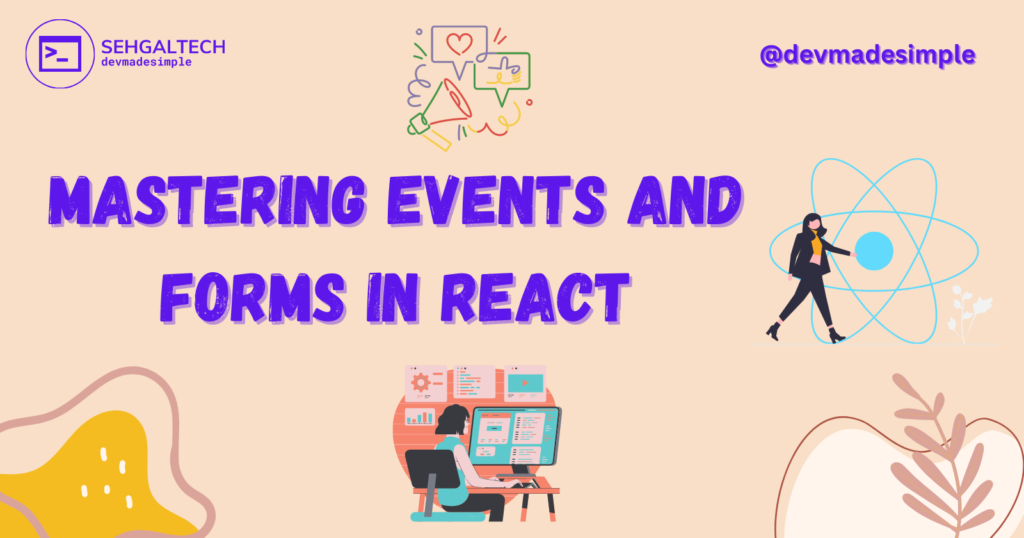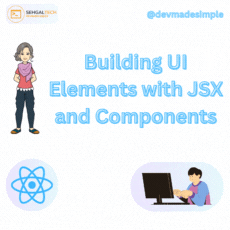Welcome back to React 101! Today, we embark on a journey into the heart of user interaction: events and forms. These fundamental concepts are your gateway to building dynamic and responsive React applications. Let’s explore how to handle user actions and collect valuable data!

Event Handling: Reacting to User Input
Imagine your React app as a stage, where users interact with your meticulously crafted components. Events are the signals sent from the audience (users) when they click, hover, or submit data. Learning to capture and handle these events empowers your app to truly respond to user input.
Here’s the basic flow:
- Event occurs: User clicks a button, types in a field, or performs another action.
- Event listener: Your component listens for specific events using event handlers like
onClick,onChange, etc. - Event handler function: This function is triggered when the event occurs, allowing you to react and update your component’s state or behavior.
Let’s see it in action:
function Greeting() {
const [name, setName] = useState('');
const handleChange = (event) => {
setName(event.target.value);
};
return (
<div>
<input type="text" value={name} onChange={handleChange} />
<p>Hello, {name}!</p>
</div>
);
}In this example, the handleChange function updates the name state whenever the user types in the input field, dynamically changing the greeting message.
Synthetic Events:
React uses synthetic events, a cross-browser wrapper, to ensure consistent event handling. Forget about dealing with browser quirks; React abstracts the differences, making your code more predictable and easier to maintain.
Forms: Capturing User Data
Forms are essential tools for collecting user input, from simple logins to complex registration processes. React integrates seamlessly with HTML forms, allowing you to manage form data and validation effortlessly.
Here’s the key concept:
- Controlled Components: Forms elements like
input,textarea, andselectcan be “controlled” by React. Their values are stored in the component’s state, and changes trigger updates. - Two-Way Binding: When a user interacts with a controlled component, the state updates, reflecting the change in the UI. This creates a two-way data flow between the user and your application.
Example:
function NameForm() {
const [name, setName] = useState('');
const handleChange = (event) => {
setName(event.target.value);
};
return (
<form>
<label>
Name:
<input type="text" value={name} onChange={handleChange} />
</label>
<p>Hello, {name}!</p>
</form>
);
}
This example demonstrates a controlled component, where the user’s name updates both the state and the displayed greeting.
3. Form Submission: Managing form submission in React is seamless. Capture user input, handle the form submission event, and interact with the collected data—all within the React component paradigm.
const handleSubmit = (e) => {
e.preventDefault();
console.log('Submitted:', username);
// Further processing or API calls can follow
};
return (
<form onSubmit={handleSubmit}>
{/* Form elements go here */}
<button type="submit">Submit</button>
</form>
);
Validation and Dynamic Forms:
- Input Validation: Ensure data integrity by implementing input validation. Leverage React’s conditional rendering to display error messages or styles based on user input.
{username.length < 3 && <p>Username must be at least 3 characters.</p>}
2. Dynamic Forms: Create dynamic forms that adapt to user interactions. Add or remove form elements based on user choices, providing a personalized and intuitive form-filling experience.
{showAdditionalField && <input type="text" />}
Beyond the Basics:
- Event Types: Explore various events like
onMouseOver,onSubmit, andonFocusfor richer interactions. - Form Validation: Use libraries like Yup or React Hook Form to ensure data quality and prevent errors.
Remember:
- Events and forms are essential for interactive user experiences.
- Start with simple examples and gradually build more complex interactions.
- Explore tools and libraries to streamline your development process.
Conclusion:
Mastering events and forms in React is pivotal for crafting interactive and user-friendly applications. With React’s streamlined event handling and controlled components, you’re equipped to create dynamic forms that seamlessly collect and validate user data. Stay tuned for more React 101 insights, and happy coding!



